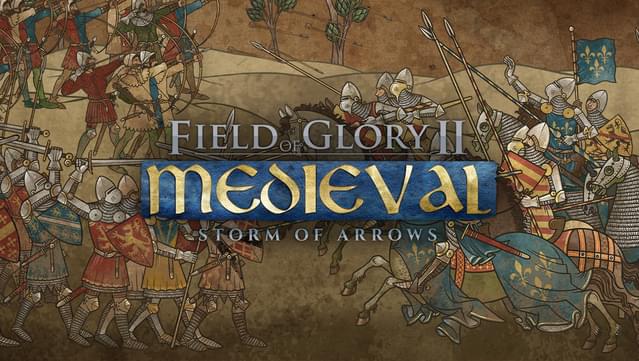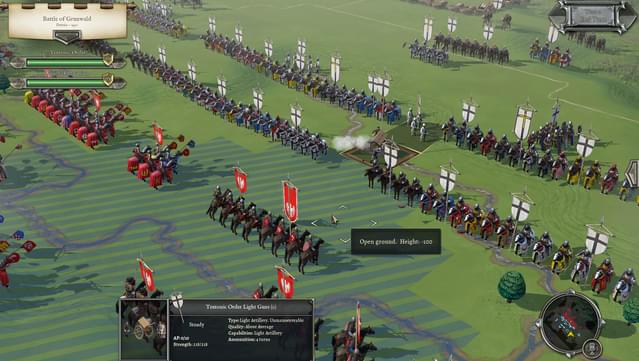Field of Glory II: Medieval - Storm of Arrows
介绍
From the early fourteenth century the battlefield dominance of the mounted knight was increasingly challenged by the rising power of the foot soldier. The Flemish spearmen at Courtrai in 1302, and the Scots at Bannockburn in 1314, showed that steady foot could defeat mounted knights. However, it was the English use of massed longbowmen combined with dismounted men-at-arms that would come to dominate western European battlefields for the rest of the 14th century and well into the 15th.
During the Hundred Years War, from 1337 to 1453, the French knights suffered a string of catastrophic defeats at the hands of this combination. After Crécy in 1346, the French knights were largely forced to fight on foot, to minimise their vulnerability to the arrow storm. Eventually, by avoiding pitched battles and concentrating on capturing important cities and castles, the French won the war and expelled the English from nearly all of their continental territories.
English longbowmen also ventured to Italy and Spain as mercenaries or allies, but warfare in these countries continued to develop rather differently from the rest of Western Europe. Italy in this period was still a collection of small independent states. The communal militia infantry had declined in importance, and had been replaced by the Condottieri as the main strength of Italian armies. These were mercenary captains who were hired to provide a company of professional armoured cavalry, and sometimes infantry.
In Spain the large Christian kingdoms of Aragon, Castile and Portugal shared the Iberian peninsula with the Muslim kingdom of Granada. In addition to fighting each other and many civil wars, there was occasional conflict with the Islamic North African powers. Spanish men-at-arms still usually fought mounted, while light cavalry continued to be more numerous than elsewhere due to the influence of warfare against Muslim armies.
Meanwhile the Swiss cantons were asserting their independence from feudal rule. Initially their massed infantry columns relied on the murderous halberd and an intimate knowledge of their own mountainous terrain.
Further east, the Teutonic Knights continued to battle against the pagan Lithuanians, but in 1386 Grand Duke Jogaila of Lithuania converted to Christianity and became King of Poland through marriage to the heiress Jadwiga. This removed the religious rationale for the Order’s activities in the region, and gave their enemy a huge boost in military potential. The Teutonic Order suffered a major defeat at the hands of Jogaila and his Polish-Lithuanian army at the Battle of Grunwald (Tannenburg) in 1410. The Golden Horde continued to dominate the Rus principalities, but the first stirrings of change occurred in 1380 when the Mongols were defeated at Kulikovo.
During the fourteenth century gunpowder artillery was introduced throughout Europe, and became increasingly important. Initially, large bombards were mainly used for siege work, but gradually smaller guns began to be employed in field battles as well.
Features:
During the Hundred Years War, from 1337 to 1453, the French knights suffered a string of catastrophic defeats at the hands of this combination. After Crécy in 1346, the French knights were largely forced to fight on foot, to minimise their vulnerability to the arrow storm. Eventually, by avoiding pitched battles and concentrating on capturing important cities and castles, the French won the war and expelled the English from nearly all of their continental territories.
English longbowmen also ventured to Italy and Spain as mercenaries or allies, but warfare in these countries continued to develop rather differently from the rest of Western Europe. Italy in this period was still a collection of small independent states. The communal militia infantry had declined in importance, and had been replaced by the Condottieri as the main strength of Italian armies. These were mercenary captains who were hired to provide a company of professional armoured cavalry, and sometimes infantry.
In Spain the large Christian kingdoms of Aragon, Castile and Portugal shared the Iberian peninsula with the Muslim kingdom of Granada. In addition to fighting each other and many civil wars, there was occasional conflict with the Islamic North African powers. Spanish men-at-arms still usually fought mounted, while light cavalry continued to be more numerous than elsewhere due to the influence of warfare against Muslim armies.
Meanwhile the Swiss cantons were asserting their independence from feudal rule. Initially their massed infantry columns relied on the murderous halberd and an intimate knowledge of their own mountainous terrain.
Further east, the Teutonic Knights continued to battle against the pagan Lithuanians, but in 1386 Grand Duke Jogaila of Lithuania converted to Christianity and became King of Poland through marriage to the heiress Jadwiga. This removed the religious rationale for the Order’s activities in the region, and gave their enemy a huge boost in military potential. The Teutonic Order suffered a major defeat at the hands of Jogaila and his Polish-Lithuanian army at the Battle of Grunwald (Tannenburg) in 1410. The Golden Horde continued to dominate the Rus principalities, but the first stirrings of change occurred in 1380 when the Mongols were defeated at Kulikovo.
During the fourteenth century gunpowder artillery was introduced throughout Europe, and became increasingly important. Initially, large bombards were mainly used for siege work, but gradually smaller guns began to be employed in field battles as well.
Features:
- Coverage for the following nations and factions from 1270 AD until just prior to the introduction of Swiss-style pike tactics and Hussite war wagons: Anglo-Irish, Aragonese, Austrian, Berber (Hafsid), Berber (Marinid), Bohemian, Breton, Burgundian, Castilian, Danish, English, Florentine, Free Canton, Free Company, French, German (Imperial, Feudal and City armies), Granadine, Hungarian, Irish, Italian (Guelf), Italian (Ghibelline), Lithuanian, Low Countries, Milanese, Navarrese, Neapolitan, Papal, Polish, Portuguese, Rus, Scots, Swedish, Swiss, Tatar, Teutonic Order, Venetian, Welsh. Each of these has their own historically-based banner.
- 45 new 14th and 15th century units.
- 95 more army lists allowing historically realistic armies for each of the above factions and their allies at different dates during the period, and bringing the total number of Medieval army lists to 241. In addition armies can include contingents from historical allies. This gives around three hundred thousand permutations. You will never run out of new matchups to try.
- Anglo-Irish 1275-1319 AD
- Anglo-Irish 1320-1399 AD
- Anglo-Irish 1400-1414 AD
- Anglo-Irish 1415-1500 AD
- Aragonese 1275-1319 AD
- Aragonese 1320-1399 AD
- Aragonese 1400-1449 AD
- Austrian 1155-1199 AD
- Austrian 1200-1319 AD
- Austrian 1320-1374 AD
- Austrian 1375-1399 AD
- Austrian 1400-1446 AD
- Berber (Hafsid) 1320-1350 AD
- Berber (Hafsid) 1351-1500 AD
- Berber (Marinid) 1320-1465 AD
- Bohemian 1320-1374 AD
- Bohemian 1375-1399 AD
- Bohemian 1400-1418 AD
- Breton 1320-1349 AD
- Breton 1350-1399 AD
- Breton 1400-1491 AD
- Burgundian 1363-1414 AD
- Burgundian 1415-1429 AD
- Burgundian 1430-1449 AD
- Castilian 1320-1399 AD
- Castilian 1400-1475 AD
- Danish 1320-1396 AD
- Danish 1397-1487 AD
- English 1272-1319 AD
- English (Britain) 1320-1349 AD
- English (Britain) 1350-1414 AD
- English (Britain) 1415-1449 AD
- English (Continental) 1320-1349 AD
- English (Continental) 1350-1414 AD
- English (Continental) 1415-1449 AD
- English (Continental) 1450-1454 AD
- Florentine 1320-1399 AD
- Free Canton 1320-1419 AD
- Free Canton 1420-1500 AD
- Free Company 1357-1414 AD
- Free Company 1415-1444 AD
- French 1320-1349 AD
- French 1350-1399 AD
- French 1400-1444 AD
- French 1445-1465 AD
- German (Imperial) 1320-1374 AD
- German (Imperial) 1375-1399 AD
- German (Imperial) 1400-1449 AD
- German (Feudal) 1320-1374 AD
- German (Feudal) 1375-1399 AD
- German (Feudal) 1400-1449 AD
- German (City) (NW) 1320-1374 AD
- German (City) (NW) 1375-1399 AD
- German (City) (NW) 1400-1449 AD
- German (City) (SE) 1320-1374 AD
- German (City) (SE) 1375-1399 AD
- German (City) (SE) 1320-1374 AD
- Granadine 1320-1492 AD
- Hungarian 1320-1440 AD
- Irish 1260-1319 AD
- Irish (Bruce) 1315-1318 AD
- Irish 1320-1500 AD
- Italian (Guelf) 1320-1399 AD
- Italian (Ghibelline) 1320-1399 AD
- Lithuanian 1300-1359 AD
- Lithuanian 1360-1385 AD
- Lithuanian 1386-1500 AD
- Low Countries 1275-1319 AD
- Low Countries 1320-1414 AD
- Low Countries 1415-1449 AD
- Milanese 1320-1399 AD
- Navarrese 1350-1378 AD
- Neapolitan 1267-1300 AD
- Neapolitan 1301-1319 AD
- Neapolitan 1320-1399 AD
- Papal 1320-1399 AD
- Polish 1320-1385 AD
- Polish 1386-1454 AD
- Portuguese 1320-1399 AD
- Portuguese 1400-1500 AD
- Rus 1265-1379 AD
- Rus 1380-1469 AD
- Scots (Britain) 1320-1338 AD
- Scots (Isles and Highlands) 1320-1493 AD
- Scots (Britain) 1339-1402 AD
- Scots (Britain) 1403-1437 AD
- Scots (Continental) 1418-1429 AD
- Swedish 1320-1396 AD
- Swedish 1397-1500 AD
- Swiss 1291-1359 AD
- Tatar 1340-1500 AD
- Teutonic Order 1320-1379 AD
- Teutonic Order 1380-1500 AD
- Venetian 1320-1399 AD
- Welsh 1400-1409 AD
- 8 more historical scenarios covering key engagements of the period on an epic scale: Courtrai 1302, Laupen 1339, Crécy 1346, Kulikovo 1380, Aljubarrota 1385, Castagnaro 1387, Grunwald 1410, Agincourt 1415.
- 48 more historical matchups added to Quick Battle mode, increasing the total to 198, playable from either side.
- 5 more historically-based campaigns covering major leaders and conflicts of the era: Hundred Years War (English), Hundred Years War (French), Sir John Hawkwood, Henry of Trastámara, Władysław II Jagiełło.
- Sandbox campaign expanded to include all the new army lists, allowing you to lead any nation (and their historical allies) against any other nation (and their allies) – giving over eighty thousand permutations.
- Time Warp modules expanded to include all the new army lists.
©2020 Slitherine Ltd. All Rights Reserved. Field of Glory II, Field of Glory II Medieval, Slitherine Ltd. and their Logos are all trademarks of Slitherine Ltd. All other marks and trademarks are the property of their respective owners. Developed by Byzantine Games
系统要求
最低系统配置要求:
推荐系统配置:
用户评论
出错,请尝试刷新页面。
没有人对这个游戏【评分
没有任何验明的所有者
对本游戏进行评分
筛选结果中没有评分
的目标
N/A
还没有评论。
显示
5一页
15一页
30一页
60一页
排序
最有帮助的
最积极的
最严苛的
最新的
筛选:
不知道该写什么?
没有与您的要求相匹配的评论
使用语言
English
Deutsch
polski
français
русский
中文(简体)
其他人
作者
已验证所有者其他人
发布于
最近30天最近90天最近6月任何时间发售后早期访问期间











